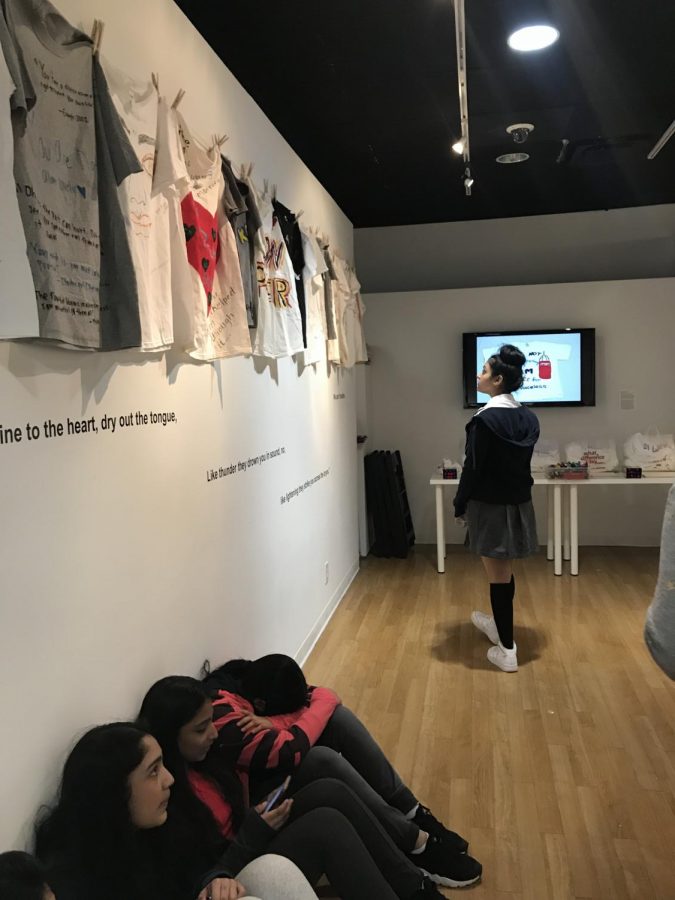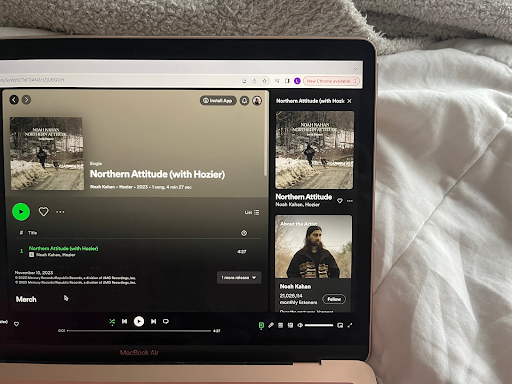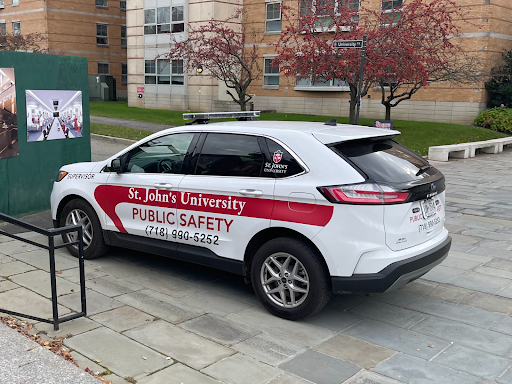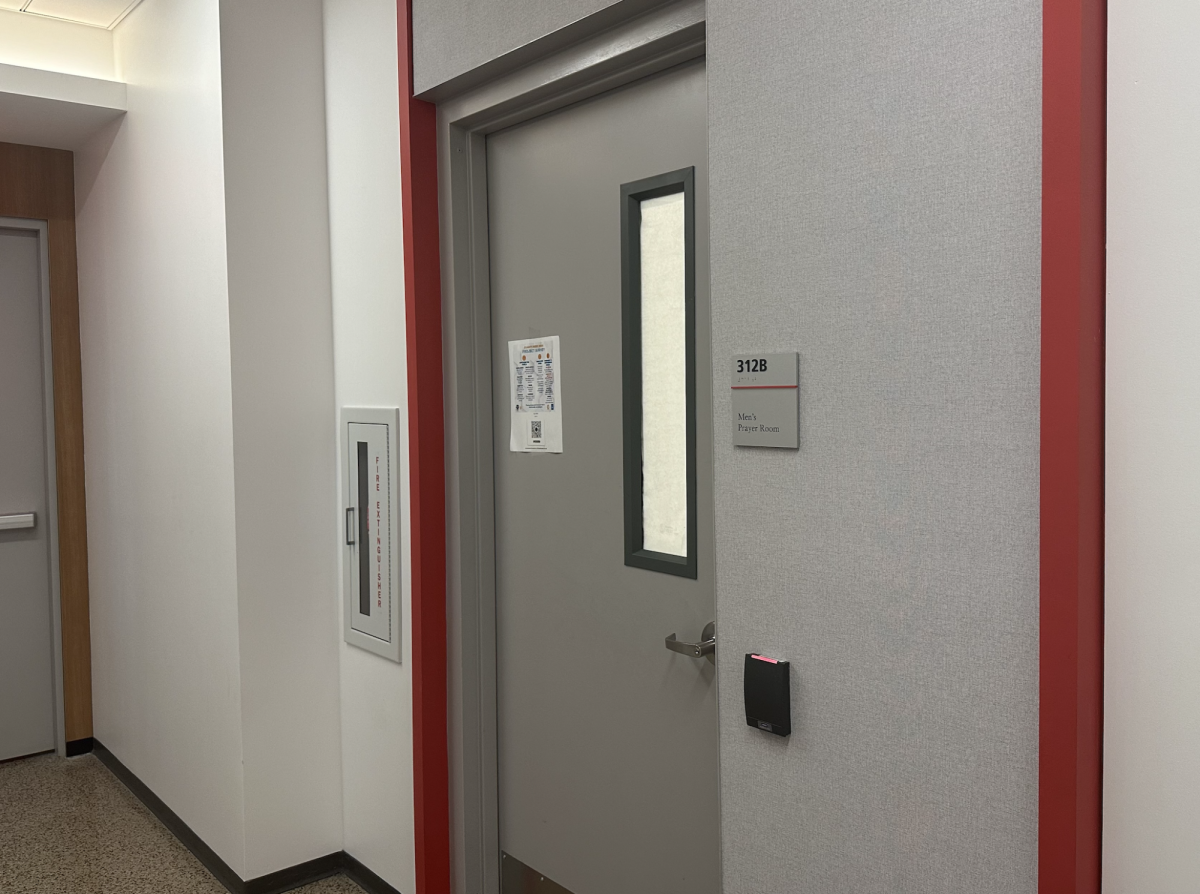The Young Women’s Leadership School of Queens visited the St. John’s Art Gallery on Wednesday, March 14 and their narratives became part of a growing collection known as the Clothesline Project.
A young girl and an old t-shirt. She doesn’t wear it, but instead, she draws on it. The marker bleeds with her best interpretation of calligraphy as her colorful story is placed upon a white, 100-percent cotton background.
“They call Me weird Names! Like ISIS, Terrorist And All Those Mean Names!” said one shirt, an example of the many types of stories that became pieces of art made by the young women.
“They did like an exhibition that represented important movements and important things in life, things that are happening every day that people don’t really talk about,” 14-year-old Saira Ali said.
The 60 ninth-grade female students that visited the Dr. M. T. Geoffrey Yeh Art Gallery were not just limited to share their own stories, but had the opportunity to view those of others.
Dr. Judith Ryder, associate professor of sociology and anthropology, currently coordinates the annual Clothesline Project on campus. The project functions as a means to both comfort and educate women and girls alike on violence.
“The clothesline actually was one way of making that connection [between women who have experienced violence and who are now criminalized] and showing that we still have a need to address the issues of victimization of women and girls,” Ryder said.
Upon entry, visitors are immediately greeted by the Clothesline Project. Gray, white and black t-shirts hang shoulder to shoulder. All in a straight line, almost as if in unity. Portraits, quotes and graphics stand out against their unembellished backgrounds.
“They have so many messages to give out but they put it in such a small piece of artwork and it means so much to them,” student Maram Gazali said on the Clothesline Project. “…and it’s really beautiful.”
On the other side of the wall stands the “Citizen” exhibit, which “features 20 artists whose work illuminates the concerns expressed by Claudia Rankine in her book of the same title,” according to the Art Gallery’s website.

Yulia Tikhonova described some of the pieces in the Yeh art gallery to the young girls.
Teaching artist Katie Rainey works once a week with the students on creative writing and art forms during their English class.
“The girls are studying ‘Citizen’ by Claudia Rankine, so this is one of the culminating things we’re doing — coming to this museum and seeing the exhibit,” Rainey said.
After an initial introduction to the Clothesline Project by Dr. Ryder, students were allowed to explore the “Citizen” exhibit on their own.
“You can’t really take things at surface value, that’s what the whole book was about, and even a lot of the pictures here,” student attendee Kayla Dike said.
“The art gallery on campus is an alternative to the classroom. It is a safe space to talk about such difficult issues as racial tensions, police brutality and microaggressions. I want to expose our students to these issues through the images created by the artists in [the] ‘Citizen’ exhibition,” Yulia Tikhonova, director of the Yeh Art Gallery said.
After the students explored the Gallery on their own, Tikhonova explained the meaning of several pieces as the students lined the perimeter of the room, listening intently. She discussed issues of oppression and discrimination, and explained how these concepts are explored and portrayed through the featured works.
Tikhonova noted the piece titled “The Central Park 5” by Brooklyn-based artist Sophia Dawson, which used Ghanaian kente cloth as the canvas for portraits of “The Central Park Five,” a group of black and latino teenagers who were wrongly accused of raping a white woman in Central Park in 1989.
“This young artist dedicated her talent to painting these young kids and other victims of police brutality,” Tikhonova said of the piece.
To conclude their visit, the girls then decorated their own t-shirts that addressed topics ranging from violence to female empowerment.
Some read, “I’m a female. Fe = Iron. Male = Man. Therefore I am Iron Man,” “Remember behind every successful man is a strong woman” and “You have a voice, so use it.”
“One of the teachers was telling me that a lot of [the students] think that we don’t need feminism anymore and [that] feminism really is of a different era,” Ryder said. “I’m hoping that the young women will see it’s important to use their talents, their art, their voices to talk about the violence that’s going on against women and girls.”
The Clothesline Project at St. John’s University started in 2008 and has been under the direction of Ryder for the past 10 years, but the first rendition in the United States was created in 1990. The Clothesline Project is part of the University’s annual Turn Off the Violence Week and will be on display both in front of and inside the D’Angelo Center next month.
















